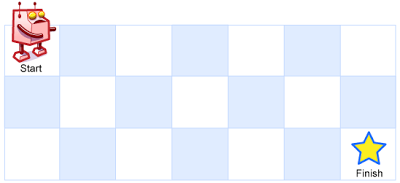There is a robot on an m x n grid. The robot is initially located at the top-left corner (i.e., grid[0][0]). The robot tries to move to the bottom-right corner (i.e., grid[m - 1][n - 1]). The robot can only move either down or right at any point in time.
Given the two integers m and n, return the number of possible unique paths that the robot can take to reach the bottom-right corner.
The test cases are generated so that the answer will be less than or equal to 2 * 109.
Example 1:

Input: m = 3, n = 7 Output: 28
Example 2:
Input: m = 3, n = 2 Output: 3 Explanation: From the top-left corner, there are a total of 3 ways to reach the bottom-right corner: 1. Right -> Down -> Down 2. Down -> Down -> Right 3. Down -> Right -> Down
Constraints:
1 <= m, n <= 100
A:
另外,其实,可以免掉recursive调用,直接在数组上来计算的。
----第二遍 Iterative way, using 2D array----
利用一维数组 using 1D arrayclass Solution {public:int uniquePaths(int m, int n) {vector<vector<int>> V(m, vector<int>(n, 0));for(int i= 0;i<m; i++)V[i][0] = 1;for(int j = 0; j < n; j++)V[0][j] = 1;for(int i =1; i<m; i++){for(int j = 1; j<n; j++){V[i][j] = V[i][j-1] + V[i-1][j];}}return V[m-1][n-1];}};
class Solution {public:int uniquePaths(int m, int n) {vector<int> V(n,1);for(int i= 1; i<m; i++){for(int j = 1; j<n; j++)V[j] += V[j-1];}return V[n-1];}};
第一个是recursively 调用,同时用一个数组,来记录已经用过的调用。
public class UniquePaths {
public int uniquePaths(int m, int n) {
// DP
int[][] pathNum = new int[m + 1][n + 1];// ignore the 0 row and col
return recursivePath(pathNum, m, n);
}
private int recursivePath(int[][] pathNum, int row, int col) {
if (pathNum[row][col] != 0) {
return pathNum[row][col];
} else {
// else ,we need calculate them
if (row == 1 && col == 1) {
pathNum[1][1] = 1;
return 1;
}
// now we can reduce their case
int stepDown = 0;
if (row >= 2) {
stepDown = recursivePath(pathNum, row - 1, col);
pathNum[row - 1][col] = stepDown;
}
int stepRight = 0;
if (col >= 2) {
stepRight = recursivePath(pathNum, row, col - 1);
pathNum[row][col - 1] = stepRight;
}
return stepRight + stepDown;
}
}
}
No comments:
Post a Comment